Inside The New York Botanical Garden
Posted in Wildlife on July 17 2019, by Patricia Gonzalez
Patricia Gonzalez is an NYBG Visitor Services Attendant and avid wildlife photographer.
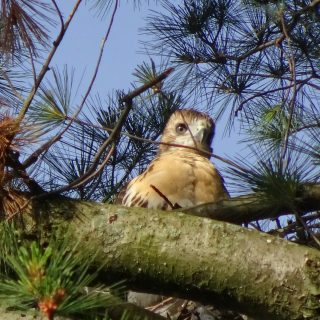 I am happy to report that for a third straight year, a pair of Red-tailed Hawks has chosen to nest at The New York Botanical Garden. A brood of three scrappy, inquisitive raptors was born in 2019, and each is now exploring the Garden.
I am happy to report that for a third straight year, a pair of Red-tailed Hawks has chosen to nest at The New York Botanical Garden. A brood of three scrappy, inquisitive raptors was born in 2019, and each is now exploring the Garden.
For Garden staff, this was an opportunity to observe an exciting natural event.
Like many of my colleagues, I like to walk the grounds during my break. Quite a few of our employees venture out with binoculars, in hopes that they might spot a fluffy little head peering out into the world, or perhaps one of the adults feeding their young. This proved a challenge, as the parents reinforced their nest to the point where it now stands much taller and wider than it was when they first constructed it in 2017, making it difficult to see what was going on.
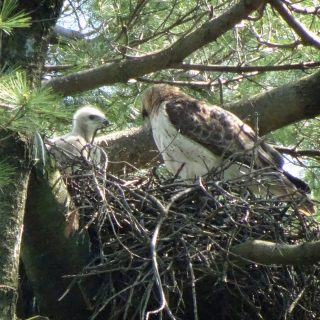 For weeks, all many of us could spot was the backside of the parents as they leaned forward into the nest bowl. Eventually, their three offspring made themselves known.
For weeks, all many of us could spot was the backside of the parents as they leaned forward into the nest bowl. Eventually, their three offspring made themselves known.
I encourage everyone to take the time to explore the 250 acres of The New York Botanical Garden. Hawks aren’t the only residents. This time of year, frogs, turtles, butterflies, and other birds call this place home.
Speaking of birds, if you prefer a group setting, join the Bird Walk that takes place every Saturday at 11 a.m. The group meets at the reflecting pool, and it is always a good time.
Posted in Adult Education, Around the Garden, Learning Experiences, Photography, Wildlife on March 15 2012, by Joyce Newman
Joyce H. Newman is the editor of Consumer Reports’ GreenerChoices.org, and has been a Garden Tour Guide with The New York Botanical Garden for the past six years.
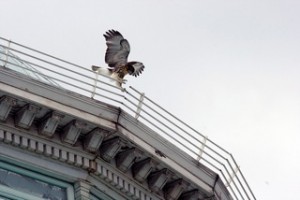 Walking by the NYBG Library Building yesterday, we spotted a huge Red-tailed Hawk as it swooped across the trees and sailed to the top of a giant oak. During the daytime, these hawks are the top avian predators in our area and very impressive to behold (at night, the Great-horned Owls reign supreme). A group of bird watchers on the path gazed upward with large binoculars and telescopes.
Walking by the NYBG Library Building yesterday, we spotted a huge Red-tailed Hawk as it swooped across the trees and sailed to the top of a giant oak. During the daytime, these hawks are the top avian predators in our area and very impressive to behold (at night, the Great-horned Owls reign supreme). A group of bird watchers on the path gazed upward with large binoculars and telescopes.
Maybe this bird is a distant cousin of Pale Male, the famous Red-tailed Hawk who settled in Manhattan in the 1990s, defying hazardous urban living conditions and continuing to produce young hawks to this day. Or it could be a cousin of last year’s celebrity Red-tailed Hawk, Violet, who enchanted the residents of Washington Square Park in Manhattan before succumbing to a heart condition. Or perhaps it is one of the Garden’s own celebrity hawks, Rose and Vince, or one of their many, many offspring.
Read More
Posted in Wildlife on June 25 2009, by Plant Talk
Find Them and Other Fledglings on Final Bird Walk of Season
 |
Debbie Becker leads a free bird walk at the Garden every Saturday from 11 a.m. to 12:30 p.m., September through June, beginning at the Reflecting Pool in the Leon Levy Visitor Center. This Saturday is her last of the season until September 5.
|
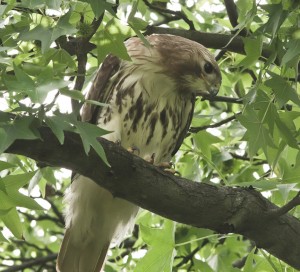 Summer—and all its activity—is just beginning for us, but this is the time when birds wind down. They began their busy season in February, in preparation for migration and nesting. They got ready for their long flight by eating more, a process called hyperphagia, so that they could go longer distances without stopping.
Summer—and all its activity—is just beginning for us, but this is the time when birds wind down. They began their busy season in February, in preparation for migration and nesting. They got ready for their long flight by eating more, a process called hyperphagia, so that they could go longer distances without stopping.
Now things have slowed for them. During the summer, though some species might have a second brood, for the most part the adults of many species, having reared their young, will be resting up for the fall migration back to their wintering grounds.
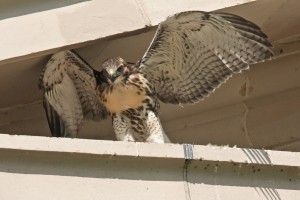 One adult pair here at the Garden—our nesting red-tailed hawks—have been kept active, however, with the successful fledging of their three babies. The siblings all took their first flight last week and can be seen hanging around the nest area—on the roof of the Library building, on nearby trees, and even on a bench, waiting for Mom and Dad to bring them food. But soon they will learn to hunt on their own.
One adult pair here at the Garden—our nesting red-tailed hawks—have been kept active, however, with the successful fledging of their three babies. The siblings all took their first flight last week and can be seen hanging around the nest area—on the roof of the Library building, on nearby trees, and even on a bench, waiting for Mom and Dad to bring them food. But soon they will learn to hunt on their own.
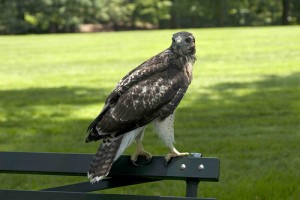 Come and look for the red-tailed hawk fledglings and other young birds on the final bird walk of the season. The walks will go on hiatus during July and August and return again September 5 in time for migration.
Come and look for the red-tailed hawk fledglings and other young birds on the final bird walk of the season. The walks will go on hiatus during July and August and return again September 5 in time for migration.
Top two photos by Richard Fleisher.
Posted in Wildlife on May 21 2009, by Plant Talk
Parents Believed to Be Fordham U. Pair
 |
Richard Fleisher is a professor of Political Science at Fordham University. He has been keeping watch at the red-tailed hawk nest at The New York Botanical Garden and chronicling the activity of the nestlings. Additional photos of the red-tailed hawks can be seen on his Web site.
|
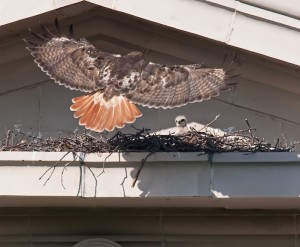 For the past four years I have watched and photographed two red-tailed hawks nest, hatch, nurture, and successfully fledge 11 young red-tails at Fordham University. The pair were named “Hawkeye” after Fordham alum Alan Alda’s character in M*A*S*H and “Rose” for Rose Hill, the Bronx campus of the University. Hawkeye is lighter in color than Rose, who has a distinctive band on her right leg. I had grown accustomed to watching this pair each spring as they fortified the nest on Collins Hall in preparation of another breeding cycle. In April the eggs would hatch, and soon young hawks that looked like little cotton balls would be visible through my scope. Very quickly these hatchlings (usually three) would get bigger, and by June they would be seen fledging (leaving the nest).
For the past four years I have watched and photographed two red-tailed hawks nest, hatch, nurture, and successfully fledge 11 young red-tails at Fordham University. The pair were named “Hawkeye” after Fordham alum Alan Alda’s character in M*A*S*H and “Rose” for Rose Hill, the Bronx campus of the University. Hawkeye is lighter in color than Rose, who has a distinctive band on her right leg. I had grown accustomed to watching this pair each spring as they fortified the nest on Collins Hall in preparation of another breeding cycle. In April the eggs would hatch, and soon young hawks that looked like little cotton balls would be visible through my scope. Very quickly these hatchlings (usually three) would get bigger, and by June they would be seen fledging (leaving the nest).
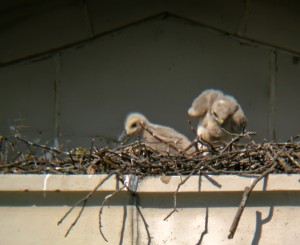 This spring, however, was different—there were no signs of the adult pair engaging in this practice. For sure, in early winter I would see them perched atop some of their favorite high spots on the campus. But when February became March and there continued to be no activity, I figured something was up. Sure enough, I got word that a pair of red-tails was nesting on the Library building at the Botanical Garden. I gathered my equipment, including my scope, cameras, 500mm lens, and tripod, to investigate the report of this new nest.
This spring, however, was different—there were no signs of the adult pair engaging in this practice. For sure, in early winter I would see them perched atop some of their favorite high spots on the campus. But when February became March and there continued to be no activity, I figured something was up. Sure enough, I got word that a pair of red-tails was nesting on the Library building at the Botanical Garden. I gathered my equipment, including my scope, cameras, 500mm lens, and tripod, to investigate the report of this new nest.
Though I cannot be sure, I am fairly confident that the pair of red-tails in the Botanical Garden is the same pair that spent the past four years on the Fordham campus. The similarities between the two nests are quite striking—both were built on a pediment of a frequently used building. In addition, it strikes me as too much of a coincidence that the same year the Fordham nest was abandoned a new nest was built by red-tailed hawks at NYBG. Finally, I got a close-up photo of the female and can see that she has a band on her right leg. (For more on the debate about whether the pair is Hawkeye and Rose, click here.)
As was the case in previous years, the pair produced three increasingly active hatchlings, which are now visible in the nest.
To learn more about the Botanical Garden red-tailed hawk nestlings…
Read More
Posted in Programs and Events, Wildlife on April 24 2009, by Plant Talk
Expect Warblers, Wood Ducks, More on this Weekend’s Bird Walks
 |
Debbie Becker leads a free bird walk at the Garden every Saturday from 11 a.m. to 12:30 p.m., beginning at the Reflecting Pool in the Leon Levy Visitor Center. This weekend, she’ll also lead a walk on Sunday, same time and place.
|
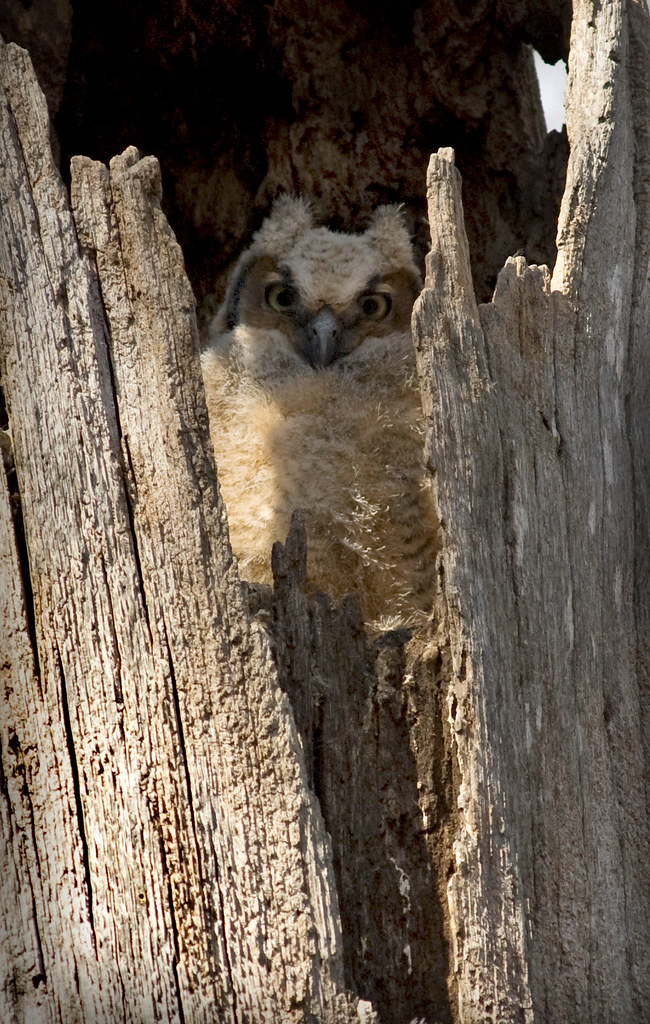 Spring has sprung at NYBG!
Spring has sprung at NYBG!
The phoebe, spring’s harbinger, has been singing its wonderful namesake song throughout the forest. Wood thrush are chiming in along with white-throated sparrows, tufted titmice, and cardinals.
While some birds are singing to lure a mate, some of our larger predators are already proud parents. Our red-tailed hawks appear to have one baby in their nest, built on a cliff-like shelf of the Library building. Mom and pop can be seen flying in and out with tasty morsels to feed the nestling.
Our baby great horned owls fledged their nest in the Forest. Last Saturday, only one baby was left in the nest (see photo) with Dad watching over him like a hawk (or should I say owl). The other owlet was somewhere in the Forest with Mom, learning how to fly and watching her hunt. Earlier this week, the second baby also fledged and now birders are treated to a spectacular show of watching them flap their brand-new wings and hop from branch to branch.
Warblers are beginning to invade the Garden. Some birders I know save all their vacation days for the last week of April and first week of May to look for these gems. Warblers are small, colorful birds that migrate from as far south as South America to the far northern reaches of the United States and southern Canada. Escaping predators and feeding on newly hatched insects, they travel up the eastern coast in the tens of thousands every April and May to their breeding grounds. This is the only chance each year to see these long-distance travelers in their brilliant breeding plumage, and birding NYBG gives you every opportunity to observe them. Last Saturday’s walk yielded a palm warbler, pine warbler, and yellow-rumped warbler.
To learn more about the birds at the Botanical Garden…
Read More
Posted in Wildlife on April 14 2009, by Plant Talk
  |
Wayt Thomas is the Elizabeth G. Britton Curator of Botany in the Institute of Systematic Botany. Stella Sylva is Administrative Curator in the William and Lynda Steere Herbarium. |
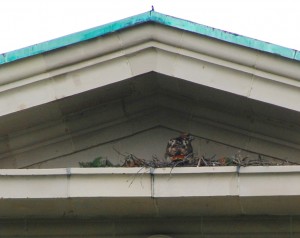 The pair of red-tailed hawks (Buteo jamaicensis) nesting on the Library building appear to be consistently present at the nest although the female is usually not visible when sitting. So, although we cannot say for sure, it is likely that she has laid eggs and is brooding.
The pair of red-tailed hawks (Buteo jamaicensis) nesting on the Library building appear to be consistently present at the nest although the female is usually not visible when sitting. So, although we cannot say for sure, it is likely that she has laid eggs and is brooding.
Their nest is in a small triangular alcove near the top of the front face of the building on the east side (see photos). The close-up photo captures the female stretching her wings and preening herself. Afterward, she went back to the middle of the nest, hunkered down, and disappeared from view. If all goes well, the eggs will hatch sometime this month. We’ll keep you posted when we find out more.
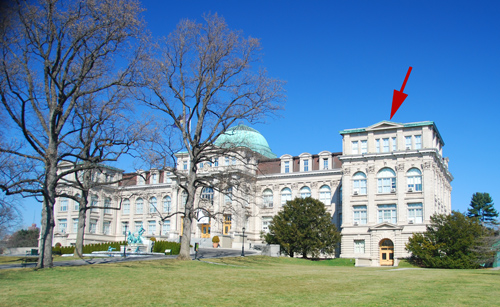
Photos by Wayt Thomas
Posted in Wildlife on March 24 2009, by Plant Talk
  |
Wayt Thomas is the Elizabeth G. Britton Curator of Botany in the Institute of Systematic Botany. Stella Sylva is Administrative Curator in the William and Lynda Steere Herbarium. |
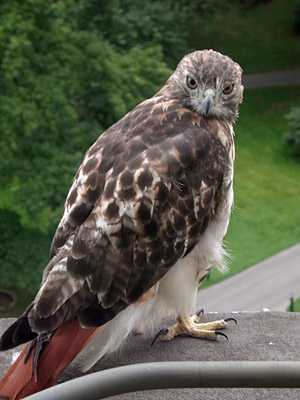
Photo by Tony KirchgessnerFor the past several weeks a pair of red-tailed hawks (Buteo jamaicensis) has been building a nest on the Library building. Their nest is in a small triangular alcove near the top of the front face of the building on the east side (see photos)—they swoop by our office windows on their way to and from the nest.
Last year they started building a nest here but changed their mind and went elsewhere—Fordham University, according to Debbie Becker, who leads the Saturday morning bird walks at the Botanical Garden. This year the hawks seem to be serious. Two weeks ago they were engaged in a very active courtship display and mated several times a day.
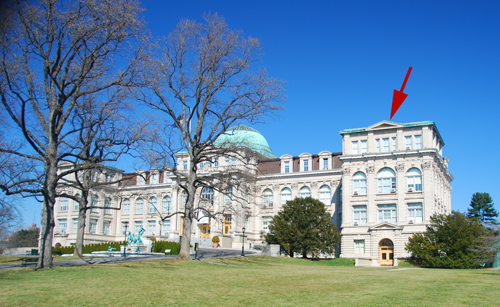
Photo by Wayt ThomasRed-tailed hawk pairs are monogamous, with females (2–4.5 lbs.) larger than males (1.5–3 lbs). The adults have a dark brown back with a pale underbelly and a darker band across the belly; the tail is brick-red above and pinkish below. Our pair is unusual in that they are accompanied by a third hawk—rarely, a second female may help tend the nest and feed the young. This immature bird is an offspring of the pair’s from last year. If everything proceeds according to what we know about these hawks, 1 to 3 eggs will be laid in late March or April—we’ll keep you posted.
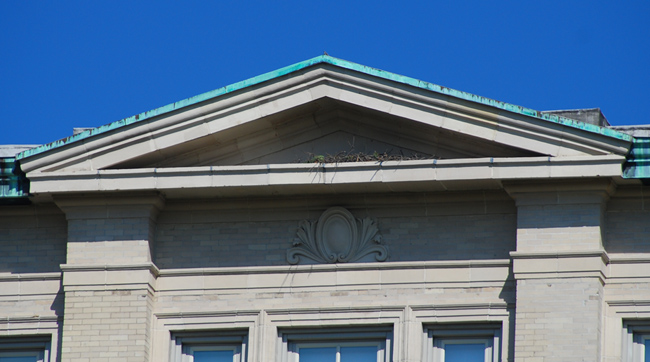
Photo by Wayt ThomasRed-tailed hawks usually feed on small mammals or birds and their preferred habitat is a mix of forest and open areas, such as we have here on the Garden grounds. Their diet consists primarily of squirrels, pigeons, small birds, and rabbits. We don’t know if they are part of the Garden’s Integrated Pest Management plan, but there are fewer squirrels than usual in front of the Library building.
Posted in Wildlife on July 21 2017, by Patricia Gonzalez
Patricia Gonzalez is an NYBG Visitor Services Attendant and avid wildlife photographer.
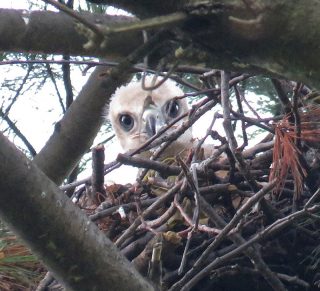 In 2017, we marked the occasion of two young Great-horned Owls fledging after having quite a few adventures during their stay in the Mertz Library nest. This was the same nest built by a pair of Red-tailed Hawks back in 2009, which also happened to be the last year that Red-tails nested at NYBG—until now.
In 2017, we marked the occasion of two young Great-horned Owls fledging after having quite a few adventures during their stay in the Mertz Library nest. This was the same nest built by a pair of Red-tailed Hawks back in 2009, which also happened to be the last year that Red-tails nested at NYBG—until now.
I’m happy to report that there are now three fledgling hawks getting to know their way around our 250 acres. Special thanks to Debbie Becker, our eagle-eyed wildlife expert, for the news! Back in April, she spotted both parents flying overhead. They soon landed in a tree in a heavily wooded section of the Garden, which became their nest. The rest, as they say, is history!
I’ve been lucky enough to follow two of the fledglings around with my camera shortly after they left the nest. It’s fascinating to watch them explore the Garden, and I look forward to watching them grow into effective hunters like their parents.
[Not a valid template]
Posted in Around the Garden, Photography, Wildlife on January 6 2013, by Patricia Gonzalez
It was a lovely Tuesday morning with cloudless blue skies. I had about an hour and a half before my shift at the NYBG began, so I decided to try my luck spotting a young Red-tailed Hawk that I’d been photographing for weeks. I believe that this is one of the three hawks born earlier this year at the Fordham University nest. His mom is Rose, who I’ve been photographing since 2008. After walking the forest for about an hour, I exited near the Wetlands Trail, where I soon saw my friend. He tried his darnedest to take on a squirrel inside the twisted snag, which resulted in a hilarious game of hawk and mouse with the squirrel living to eat peanuts another day.
I also had an opportunity to shoot a little video of the pair in action, which you can see here.
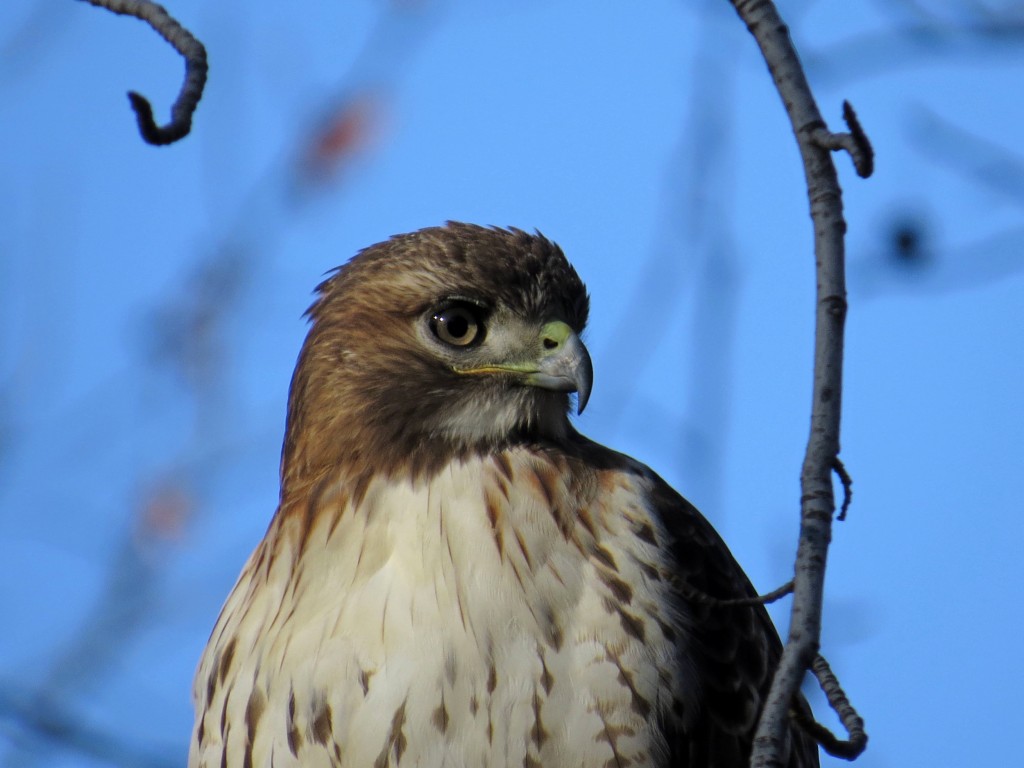
Photo by Patricia Gonzalez
Posted in Wildlife on February 18 2010, by Plant Talk
Bird Watchers Witness Drama During Weekly Walk
 |
Debbie Becker leads a free bird walk at the Garden every Saturday from 11 a.m. to 12:30 p.m. beginning at the Reflecting Pool in the Leon Levy Visitor Center.
Photo of owls: Debbie Becker
|
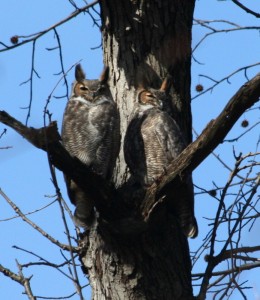 Late last month, in frigid weather conditions, 12 loyal birders met me under the clock at 11 a.m. for the weekly bird walk around the Garden. Our main objective was to see the nesting great horned owls. We headed over to the snag at the Forest’s edge where the owls successfully nested last year, and there in a cavity we saw our resident female owl, all fluffed up sitting, presumably, on eggs—only the top half of her body was visible.
Late last month, in frigid weather conditions, 12 loyal birders met me under the clock at 11 a.m. for the weekly bird walk around the Garden. Our main objective was to see the nesting great horned owls. We headed over to the snag at the Forest’s edge where the owls successfully nested last year, and there in a cavity we saw our resident female owl, all fluffed up sitting, presumably, on eggs—only the top half of her body was visible.
We then searched for the male owl, who usually is nearby, guarding the nest and his mate. Our binoculars scanned the bare branches of surrounding trees until we spotted him wedged between the trunk and a branch of a tree. Three blue jays were harassing him—screeching at the top of their lungs. When one jay got too close, the owl flew to a branch closer to us.
 As we stood there freezing and admiring his majestic beauty a red-tailed hawk flew in and landed about 20 feet away from the owl. This wasn’t any red-tailed hawk—it was the female that nested on the Library building last spring. She and her mate (he later died from eating a poisoned rat) had three offspring; she and her brood often can be seen flying around the Garden searching for prey. We had seen the female many times before, silently perched waiting for some unsuspecting squirrel or rabbit to happen by.
As we stood there freezing and admiring his majestic beauty a red-tailed hawk flew in and landed about 20 feet away from the owl. This wasn’t any red-tailed hawk—it was the female that nested on the Library building last spring. She and her mate (he later died from eating a poisoned rat) had three offspring; she and her brood often can be seen flying around the Garden searching for prey. We had seen the female many times before, silently perched waiting for some unsuspecting squirrel or rabbit to happen by.
Read More
 I am happy to report that for a third straight year, a pair of Red-tailed Hawks has chosen to nest at The New York Botanical Garden. A brood of three scrappy, inquisitive raptors was born in 2019, and each is now exploring the Garden.
I am happy to report that for a third straight year, a pair of Red-tailed Hawks has chosen to nest at The New York Botanical Garden. A brood of three scrappy, inquisitive raptors was born in 2019, and each is now exploring the Garden. For weeks, all many of us could spot was the backside of the parents as they leaned forward into the nest bowl. Eventually, their three offspring made themselves known.
For weeks, all many of us could spot was the backside of the parents as they leaned forward into the nest bowl. Eventually, their three offspring made themselves known.











 The
The 






